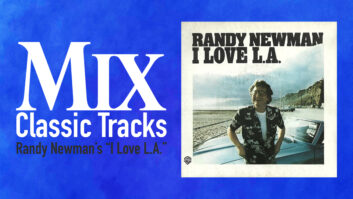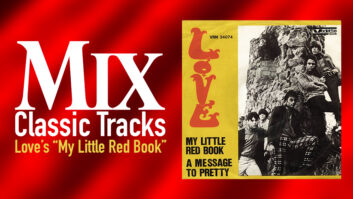
Philadelphia was certainly hoppin’ in the early ’70s, thanks in large part to the music scene that revolved around owner/engineer Joe Tarsia’s Sigma Sound Studios. Tarsia’s roots actually go back to the Philly teen-pop of late-’50s/early ’60s acts like Bobby Rydell and Chubby Checker, but by the time he opened Sigma on North 12th Street in August 1968, there was an exciting new brand of Philadelphia soul music taking root: The songwriting/production team of Kenny Gamble and Leon Huff, as well as producer/arranger Thom Bell, started churning out an incredible parade of hits, most of them recorded at Sigma by Tarsia. Acts associated with those producers—such as Jerry Butler, Wilson Pickett, The Delfonics, The Stylistics, Harold Melvin & The Blue Notes and The O’Jays—made Sigma one of the top recording studios in the country and helped Philadelphia surpass Detroit (still reeling from the relocation of Motown to L.A. in the early ’70s) as the nation’s soul music headquarters.
And then there were The Spinners, who were, ironically, from Detroit; their roots go back to the mid-’50s when a group of friends formed a vocal group called The Domingoes. By 1961, a core foursome of tenors Bobbie Smith and Billy Henderson, baritone Henry Fambrough and bass Pervis Jackson (plus tenor George Dixon, whose spot changed a few times) had solidified into a unit called The Spinners, and they enjoyed a couple of minor hits for Harvey Fuqua’s Tri-Phi Records label, which was later bought out by Motown’s Berry Gordy. The Spinners did not fare well at Motown, and by the late ’60s, the group had mostly been reduced to menial tasks with the company. In 1970, however, The Spinners moved to a new Motown imprint called V.I.P. Records and made it into the Top 20 with a Stevie Wonder–written/produced tune called “It’s a Shame.”
At the suggestion of Aretha Franklin, The Spinners left the Motown stable and signed with Atlantic Records in early 1972. Along the way, they brought in Philippe Wynne to be their new co-lead tenor (along with Smith) and went to Philadelphia to see if Thom Bell could work his magic with the group at Sigma Sound. It worked. With Bell choosing the songs, writing the arrangements and handling the production, and Tarsia engineering, The Spinners had their first million-selling single with “I’ll Be Around,” followed by hits “Could It Be I’m Falling in Love,” “One of a Kind (Love Affair)” and “Ghetto Child.”
This month’s “Classic Track,” “Mighty Love,” was another Bell triumph for The Spinners. It was recorded at Sigma in 1973 by engineer Don Murray, who had been Tarsia’s assistant beginning in 1970, but had graduated to helming Bell sessions while Tarsia devoted most of his time to working on Gamble & Huff productions. “When I first started at Sigma, I had to come up to speed pretty fast because my background was in music, not engineering,” says Murray, whose four-decade, multiple Grammy-winning career has included hundreds of albums in different genres. “I knew the studio from working there [as a musician]. On my first day at work, I was assisting Joe on a big Gamble & Huff rhythm section. There was no such thing as a training period. I was setting up the studio and running the tape machine from day one. It was great watching Joe and learning from him—he’s a brilliant engineer.
“The first two years I was assisting and doing a lot of smaller sessions that didn’t bring in as much money,” Murray continues. “But they were hard sessions because a lot of them were direct-to-2-track—a gospel choir with a rhythm section would come in and rent the studio for three hours and they wanted to walk out with a mix, so it was live to 2-track or live-to-mono. I really learned quickly working on those types of sessions.”
Murray describes Sigma’s main recording room as “good-sized, but not huge; big enough for what we were doing. It had a high ceiling and it sounded really good. It had that old-style acoustic tile all over the walls and linoleum floors.” At the time, Sigma’s control room was equipped with a custom 32-input Electrodyne console and a Scully 16-track recorder. The engineers mainly used outboard API and Orban EQs. A 40x6x12-foot echo chamber was situated right next to the control room, and Tarsia pioneered mixing a chamber signal with a mono EMT plate to create stereo reverbs. (“Then stereo plates came in,” Murray notes.) For microphones, the workhorses at Sigma were multiple Neumann U87s used on everything from vocals to strings. Additionally, Tarsia and Murray employed RCA 77s on brass, vibes and B-3 Leslies; an Altec “salt shaker” on snare; an RCA BK5 on the kick; and AKG 451s on toms and guitar amps.
Typically, both Bell and Gamble & Huff sessions would be broken into different days of emphasis. Day one (and sometimes two) would be capturing the “rhythm section” live in the studio; rather than just rhythm guitar, bass and drums, it usually included three guitarists, a keyboardist and percussionists playing congas and vibes or marimba.
“It was like a factory,” Murray says. “We would do a rhythm section day, 10 to 6; we would never go much more than eight hours cutting tracks. It might take a couple of days to get your basics on everything for an album.”
Once the tracks were down, the vocal group would come in, with the lead vocal put on first and then backing vocals. Another day might find a small horn section added in the morning and strings in the afternoon. Typically, the string section included eight violins, two violas and one cello (with four mics—two on the violin section, one each for violas and cello), doubled. “The string players didn’t use headphones back then,” Murray recalls. “They used a little speaker [for reference], and when they doubled the strings we flipped them out of phase so it would cancel out the speaker noise. So those strings would be out of phase—maybe that contributed to the sound of those records; I don’t know. Around that time, Thom started experimenting with bigger string sections.”
Mixing was on the Electrodyne with the engineer and producer(s) riding the faders. “I loved manual mixing in those days,” Murray says. “It was like a performance; very exciting and also very satisfying when you got it right.”
Murray says admiringly of producer Bell, “I’ve never seen anyone else quite like him. Gamble and Huff had a big production machine, and they used a lot of people, a lot of arrangers, writers. Thom Bell was a one-man operation. He co-wrote a lot of the songs, played the keyboards, wrote all of the arrangements, sang backgrounds and told the singers exactly what to sing. He did everything. And he was a real ‘up’ guy, very energetic. He comes into the room, and it’s electric. That was quite an experience for me. I’ve worked with a lot of people through the years, and he’s definitely up there with the best—genius category. He was amazing.”
It helped that Bell and Gamble & Huff had a spectacular group of musicians to work with. Though (still) not as well known as Motown’s players, they were every bit as good. On The Spinners’ “Mighty Love,” a tune written by “Philly Sound” favorites Joseph Jefferson, Bruce Hawes and Charles Simmons, the studio band was comprised of the usual Sigma suspects: drummer Earl Young, bassist Ronnie Baker, Bell on keys, Larry Washington on congas, Vince Montana on vibes and, on guitars, Murray says, “Norman Harris would always play the [Gibson] L5-type guitar part—he’d play the melody and chords—Bobby Eli would play the backbeat rhythmic part and Roland Chambers would play anything that had to do with little fuzz lines or wah-wah; more effect-y parts. This band could play anything so tracking was always fairly easy.”
Unlike most of The Spinners’ Atlantic hits, which feature either Phillipe Wynne or Bobbie Smith on lead vocals, “Mighty Love” has the two alternating on lead tenor, until about the midway point in the 5-minute song when Wynne takes over and ad-libs over the “out” for more than two minutes—not uncommon for soul tunes in this era when dance numbers were beginning to stretch out (in anticipation of the imminent arrival of disco, perhaps). “Thom usually told everyone exactly what to sing, but he didn’t do that with Philippe, at least not on that song. That incredible ad-lib thing at the end was a first take—he just went in there and did it. That was an amazing thing to be in the same room for.” The backing vocal session included both lead singers; group vocalists Jackson, Henderson and Fambrough; and four women backups: Linda Creed (Bell’s frequent co-writer), Barbara Ingram, Carla Benson and Yvette Benton.
Asked how involved The Spinners were with other phases of their music’s creation or production in that era, Murray replies, “Not much at all. It was totally the ‘Thom Bell Show.’ The group wouldn’t come in until it was their vocal session. That was the way Thom liked to work.”
With its big main riff dominated by stirring strings and horns, its bright vocals and optimistic message, “Mighty Love” was firmly from the classic Philadelphia soul mold, and the song soared to Number One on the Billboard Soul Singles chart (and got as high as Number 20 on the “Hot 100” Pop Singles chart) in the winter of 1974. Actually, the “hit” was an edit of the album track—dubbed “Mighty Love, Pt. 1,” the song faded at about the 3:15 mark, eliminating Wynne’s long ad-lib section. (The B-side of the single was “Pt. 2.”)
The Mighty Love album peaked at Number 16 on the Billboard Albums chart and produced two other smash singles: “Coming Home” (written by Bell and Linda Creed) and “Love Don’t Love Nobody” (by Jefferson and Simmons). Bell also won the Grammy for Producer of the Year at the 1975 ceremonies. That year, Bell moved to Seattle and Murray relocated to Los Angeles. “I would go up to Seattle and he’d bring in the Philly musicians and we’d do Spinners albums [at Kaye-Smith Studios] and other groups. He did the Elton John EP [The Thom Bell Sessions, cut in 1977] up there. We’d still go do the string and horn arrangements back in Philly and then he’d mix mostly in Seattle. We also did some recording and mixing in L.A., too.”
As for The Spinners, they had a couple more big hits before Wynne left the group in early 1977 (replaced by John Edwards), and their association with Bell ended two years after that. Still, they continued to turn out hits into the early ’80s and nurtured a huge following in England. There has been tremendous turnover within the group in the years since then, but The Spinners have managed to thrive on the oldies/nostalgia circuit. Bobbie Smith and Henry Fambrough are the sole remaining original members.
“We got spoiled with every song being a hit for Gamble, Huff and Bell,” Murray says today of that golden time. “I look back on it now and I can’t believe I was a part of it!”







